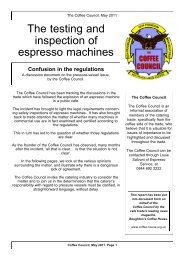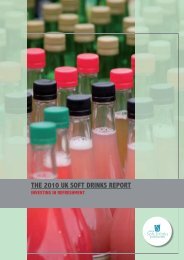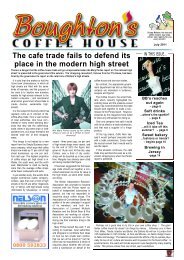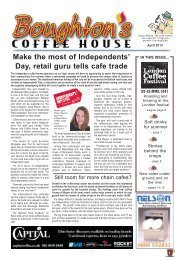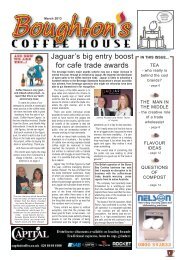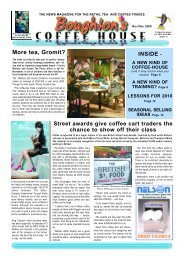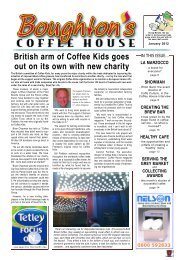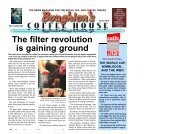World's greenest roaster is set for UK launch - Boughton's Coffee ...
World's greenest roaster is set for UK launch - Boughton's Coffee ...
World's greenest roaster is set for UK launch - Boughton's Coffee ...
You also want an ePaper? Increase the reach of your titles
YUMPU automatically turns print PDFs into web optimized ePapers that Google loves.
wasn't ours (although we do a lot of<br />
their international work) was a good<br />
idea."<br />
So, should takeaway cups be bought<br />
as a commodity or as an as<strong>set</strong>?<br />
"Sometimes, the more 'aggressive'<br />
buyers in the trade do actually come to<br />
appreciate the value of the product - but<br />
they still don't w<strong>is</strong>h to pay the price <strong>for</strong><br />
what it delivers!<br />
“You wouldn't believe the battles we<br />
have on 'commercial positioning', and<br />
it's not as if we're making outrageous<br />
demands - but considerable addedvalue<br />
does come at a price. If the number<br />
of things th<strong>is</strong> product can do were<br />
embraced more fully, the takeaway cup<br />
would be seen as a great as<strong>set</strong> to the<br />
trade.<br />
"It's very sad that these things are<br />
bought as commodities and not with<br />
appreciation or understanding."<br />
As a prize in a current trade contest,<br />
café operators get to go round the<br />
Huhtamaki site in Gosport. Th<strong>is</strong> <strong>is</strong> a<br />
chance to put across appreciation of<br />
cups, says John Young.<br />
"I look <strong>for</strong>ward to operators appreciating<br />
the technology which goes in to<br />
what they think of as a cheap throw -<br />
away item.<br />
“As an industry, we and the caterers<br />
both have consumers who leave a cup<br />
on their desk <strong>for</strong> 30 minutes and expect<br />
it to remain an acceptably-hot drink. We<br />
also have both traders and consumers<br />
who expect ever-larger sizes of drink,<br />
which places technological demands on<br />
us - larger sizes of drink have required<br />
stronger cups and a different 'hoop'<br />
strength, which <strong>is</strong> the flexing strength of<br />
the cup. The fabric flexes one way with<br />
a lid, another way without, and the rim<br />
plays a part as well. These are <strong>is</strong>sues<br />
which are important.<br />
"And don't <strong>for</strong>get that lid - th<strong>is</strong> plays a<br />
key role. It's true that there are some<br />
very good ones, and it's true that there<br />
are some which are hell<strong>is</strong>hly expensive,<br />
which <strong>is</strong> an example of the better product<br />
having its price.<br />
"Sometimes the buyer's focus stays<br />
too much on the cup, but the lid <strong>is</strong> still<br />
critical. There are still a lot of customers<br />
who buy our cup and somebody else's<br />
lid, or vice-versa, and while that may<br />
technically work, if you get to a spillage<br />
or burn case, then who has ownership<br />
of the problem? In a world of claims<br />
<strong>is</strong>sues, the prec<strong>is</strong>ion of cup and lid <strong>is</strong><br />
critical."<br />
We have heard of a new Detpak<br />
product, <strong>for</strong> which we are not yet<br />
given details - th<strong>is</strong> <strong>is</strong> Vivo, apparently<br />
a kind of print to be used on ripplewrap<br />
cups… but we have as yet to dig<br />
up any firm in<strong>for</strong>mation on it.<br />
There <strong>is</strong> now a proven demand <strong>for</strong><br />
used takeaway cups – paper mills<br />
cannot get enough of them.<br />
Barry Read of the Paper Cup<br />
Recycling Group, whose activities we<br />
have reported on closely <strong>for</strong> some<br />
time, tells us that the group has now<br />
fin<strong>is</strong>hed a trial in which virtually all the<br />
fibre from polyethylene-coated paper<br />
cups was successfully extracted, then<br />
converted into high-quality t<strong>is</strong>sue fibre<br />
<strong>for</strong> use in products such as facial and<br />
toilet t<strong>is</strong>sues.<br />
The paper mill involved was so<br />
pleased with the quality of fibre that it<br />
asked about the chances of receiving<br />
at least 10 tonnes of used cups each<br />
month.<br />
"Th<strong>is</strong> <strong>is</strong> really exciting,” he told us. “I<br />
don’t know how many tonnes of cups<br />
have been passed through to our mill<br />
partners, but a 20-tonne load of suit -<br />
able recovered paper cups each week<br />
would be no problem! Estimates suggest<br />
that somewhere between 70,000<br />
and 100,000 tonnes of paper cups are<br />
used each year and recovering 20 per<br />
cent of that would not present any<br />
problem when reprocessing."<br />
However, the majority of takeaway<br />
cups will never reach such a constructive<br />
end, which <strong>is</strong> why the industry <strong>is</strong><br />
so concerned with first, making the<br />
things from sustainable materials, and<br />
second, making cups which can be<br />
composted or which will bio-degrade<br />
at the end of their life.<br />
Un<strong>for</strong>tunately, th<strong>is</strong> now means that<br />
many cup salesmen repeat the words<br />
'biodegradable' and 'compostable' like<br />
a mantra, without knowing what<br />
they're talking about, we complained<br />
to Marcus Hill, managing director of<br />
London Bio-packaging.<br />
H<strong>is</strong> company operates a 'closed<br />
loop' system, by which customers are<br />
helped to keep waste in the correct<br />
bins to operate a pure compostable<br />
waste stream. He collects the com -<br />
postable waste on a regular bas<strong>is</strong> and<br />
takes it to a commercial composting<br />
facility.<br />
"Our cups are made from certified<br />
sustainable <strong>for</strong>est paper lined with<br />
NatureWorks Ingeo bio-plastic. Th<strong>is</strong><br />
means the cup has a lower carbon<br />
footprint, as bio-plastics emit less carbon<br />
when made than the oil-based lining<br />
on conventional cups.<br />
London Bio-packaging also made its<br />
own ‘ripple’ cup, a popular handling<br />
<strong>for</strong>mat but one not normally recycla -<br />
ble. "Ours have a conventional PE lining<br />
so cannot be composted, but they<br />
are made from sustainable <strong>for</strong>est<br />
paper and can be recycled. We are<br />
currently developing our bio-plastic<br />
lined ripple cup and hope to <strong>launch</strong> it<br />
th<strong>is</strong> winter."<br />
Planglow has also created its own<br />
11<br />
Biological battles<br />
One of the biggest debates of all in the takeaway cup sector <strong>is</strong><br />
the question of environmentally-friendly materials, waste and<br />
recycling. A lot of nonsense <strong>is</strong> spoken - but a lot of good work<br />
<strong>is</strong> also being done.<br />
A ripple, but not as we know it -<br />
Planglow’s new Bio-cup<br />
variation on the ‘ripple’ cup, and<br />
although th<strong>is</strong> <strong>is</strong> described as 'an ecoalternative<br />
to Detpak', the company<br />
which establ<strong>is</strong>hed the ripple <strong>for</strong>mat,<br />
Planglow <strong>is</strong> still happy to d<strong>is</strong>tribute the<br />
original.<br />
"The Detpak Ripple-wrap <strong>is</strong> a great<br />
cup and customers do like it," says<br />
Rachael Sawtell of Planglow.<br />
"However, we were increasingly<br />
being asked by our customers <strong>for</strong> a<br />
100-per-cent bio cup – all of our other<br />
products are biodegradable and compostable,<br />
and we needed a cup to fit<br />
with the range.<br />
"The new cup we are offering offers<br />
the best of both worlds as it has<br />
ridges, but not pronounced ones. Th<strong>is</strong><br />
means that the print <strong>is</strong> clear and you<br />
also get the benefits of a double<br />
walled cup. Images become much<br />
clearer, particularly if photographic<br />
imagery or wording <strong>is</strong> used. We<br />
already have a number of customers<br />
that are changing over."<br />
The cups are made from card with a<br />
PLA lining.<br />
Will the cups actually get to the right<br />
waste stream?<br />
"The truth of the matter <strong>is</strong> that the<br />
majority of food-to-go packaging<br />
waste will end up in landfill as unless<br />
there are kerbside facilities, no one <strong>is</strong><br />
going to carry their used takeaway<br />
Continues on next page



